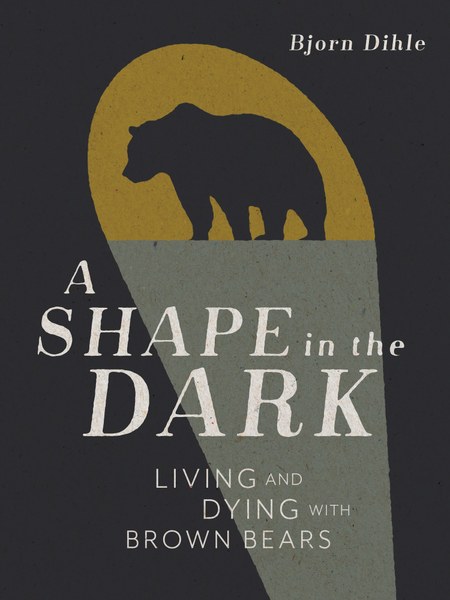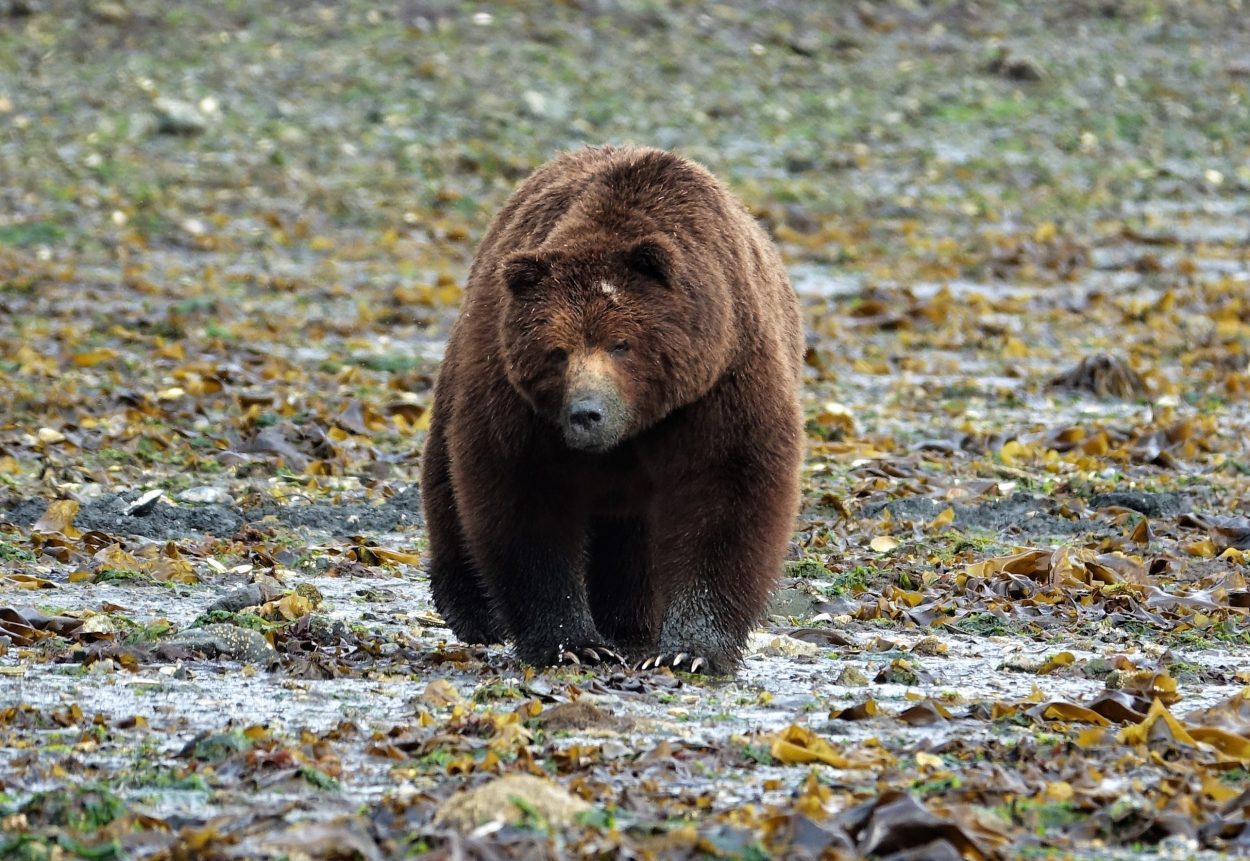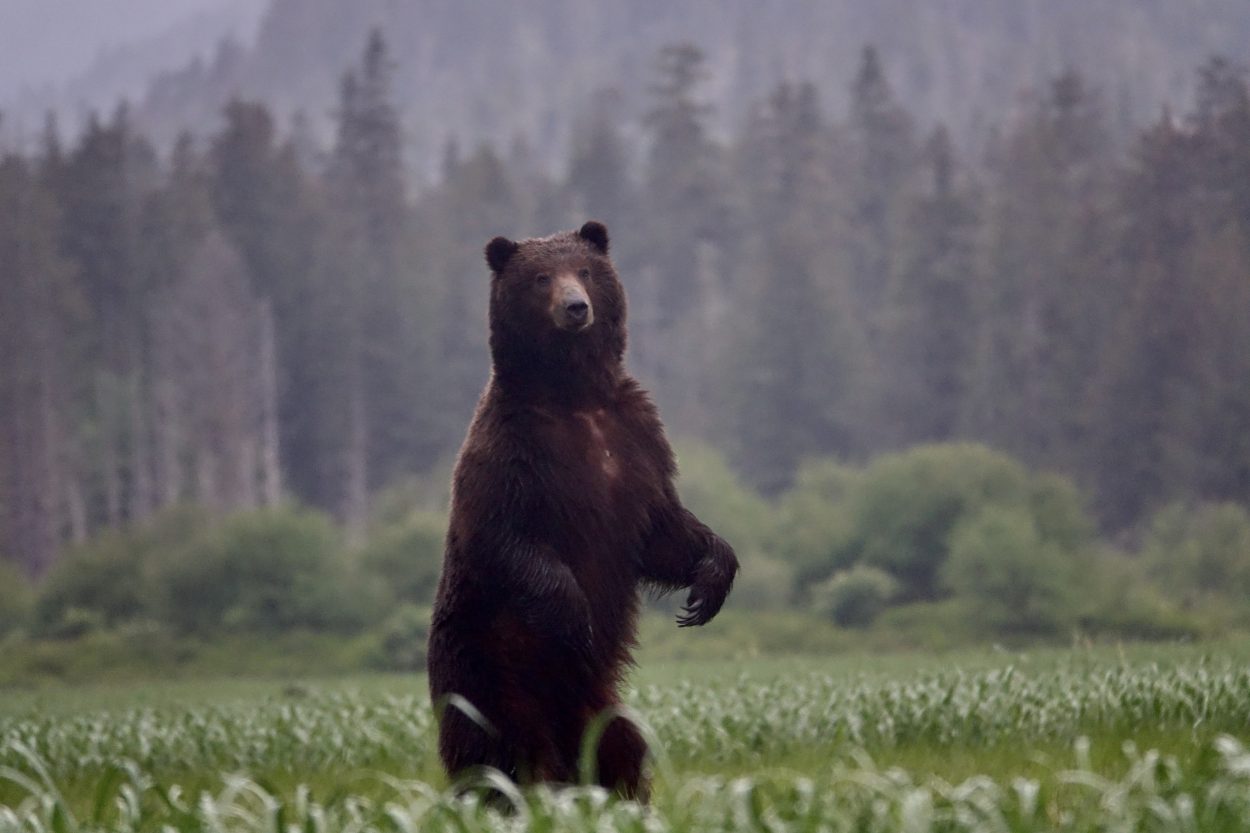
“A Shape in the Dark: Living and Dying with Brown Bears” is a new book by Juneau writer and wilderness guide Bjorn Dihle. It’s a portrait of brown bears and their complex relationship with humans. It combines a sweeping historical perspective with Dihle’s own experience and interviews with others in the field. He sat down with CoastAlaska’s Jacob Resneck to discuss conservation ethics over the last century, trophy hunting and belting out classic rock tunes to survive in grizzly country.
Jacob Resneck: There’s been a lot of books written about Alaska bears. When you set out to write this one, what were some of the stories of points you were trying to include that you hadn’t seen in the rest of the literature?
Bjorn Dihle: I set out to write this book, just because I kind of wanted to, like, tell a bigger story of our relationship with brown bears specifically. And you know, there’s a lot of bear terror stories, bear hunting stories or bear cuddling stories. And I wanted to get at the root of where all these stories kind of spring from. So yeah, when I set out to write this, it was kind of like, a more holistic sort of deal. And then at the same time, it’s just, you know, growing up in Southeast Alaska and living here today, and having been lucky enough to travel around brown bear country all over the state, it’s also … there’s no other species of animal than the brown bear that’s challenged and intrigued me more. So it’s also just kind of writing this book was a way of me kind of coming to terms with my own relationship with the brown bear.
JR: When you submitted your first draft of the manuscript, and you and you gave it to your editors, what did they say?
BD: I was gonna write a book about brown bears that wasn’t scary. And then by the time I was done with my draft, I was like, ‘Well, this is scary.’ And then I just kind of was like, ‘Well, you can’t make brown bears not be scary.’ They’re scary animals, there’s no way around it. So when I sent it in to the editor there she really liked it a lot. But she was like, you know, you mentioned earlier about not wanting this to be a scary book. And she’s like, ‘I’m terrified.’

Excerpted from A Shape in the Dark:
“For a second, before I remembered to be afraid, I was overcome by its sheer presence. Dark brown with silver forelegs, incredibly muscled and poised, it appeared too real to be real. A moment later, our eyes met. Fear and rage flashed in its small brown eyes. It closed the distance separating us in one stride as I reached for my bear spray attached to my pack strap. There wasn’t time to unclip it. There wasn’t even time to realize the bear was about to knock me down and what that might mean. But instead of smashing me, the bear stopped short — at what felt like only inches away — and recoiled to the side. I took a step back and was fumbling with my pepper spray when the bear came again and, just before contact seemed inevitable, bounded away. For the longest seconds of my life, we participated in a strange and violent dance until the bear crashed off into the willows. It was only then that I had the pepper spray in my hand and ready. During the rest of the hike out, every set of grizzly tracks I came across seemed to radiate with the promise of death. At any moment, I expected a bear to emerge from the mountains and come for me.“
JR: Yeah, because a lot of the book, you’re describing some pretty intense experiences of being in their territory and feeling physically afraid. But as you get more experience, as someone in the wilderness, what are some of the techniques you learned to de-escalate your encounters and avoid things from going south?
BD: I mean, the first thing is just being aware of, you know, when you’re in bear country, how to travel safely through it, you know, there’s some areas where you just shouldn’t go unless you’re, you’re really experienced. If you’re seeing lots of bear sign, chances are you should not be there. But I’d say probably the most interesting thing I learned over the years with bears, as far as de-escalating scenarios, is just how incredibly responsive they are, to being talked to, to your body language. These animals communicate 98% through body language. So the way you hold yourself is critical. And honestly, in my opinion, they respond better. They’re better listeners than people.
Trying to de-escalate a person who’s agitated and scared is way harder than trying to de escalate a brown bear that’s agitated, angry and scared. If you give them the chance, you know, by being calm, cool and collected. You know, they respond, they tend to respond incredibly well.
But then there are those stories where it’s like, well, this person was walking down the street and a bear nailed them. So there are bad bears out there. You know, at any given moment, no matter how experienced you are. That doesn’t exclude you from being attacked by a bear no matter what you’ve done for conservation, the species does not exclude you from being hurt by a bear.

JR: You know, so bears are pretty celebrated in Alaska, especially brown bears, but as you write in your book, and you show, historically, that wasn’t the case. It wasn’t very long ago, actually. And some of the attitudes during territorial days. It was like a zero sum game. It was them or us: brown bears were seen as this impediment to development or even human habitation. Can you talk a little bit about that part of the story?
BD: Yeah, a lot of the book begins with Meriwether Lewis [of Lewis & Clark expedition — ed.] and covers Westward Expansion. That attitude of zero tolerance, no room for bears is very prevalent. And I think one of the most interesting things about Alaska is that we are, I’m not gonna say that we’re like an enlightened age, but we have enough varying opinions and different ideas and perspectives to accommodate brown bears, which is really remarkable.
During the territorial days, you know, Admiralty Island is just such a good example. The head biologist for the Forest Service in the early 1930s, late 1920s, I think his name was Jay Williams, he recommended killing all the brown bears to make it safer, to clear cut log Admiralty Island. That sort of idea today is just, you know, people would say that’s insane.
JR: Guiding trophy hunts for brown bears is big business in rural Alaska. In the book, you talk to a number of guides, whose livelihood depends on these hunts. And you found a range of attitudes among guides who take people paying big money just to come and kill an Alaska brown bear. What are some of the attitudes you got from talking to those guides?
BD: The one common theme, I would say is that there is this reverence for brown bears in wilderness areas that just about every guide I talked to you like it was that was very important, the idea of conservation is very important. There are obviously bad guides to who don’t care about, you know, the species and whatnot. But, you know, I think the most interesting thing that I came across talking to hunting guides was how often the word intimacy popped up, when they’re talking about why their clients want to hunt, brown bear versus even another animal. And, you know, the intimacy was always greater with the brown bear. Which, I mean, that’s an interesting thing to think about. I’m not going to go off on it too much. You know, make your own conclusions on that one.
One of the guides you know, is talking about how emotionally complicated brown bear hunting is versus hunting other animals, specifically animals that you eat. While brown bear, generally, is not eaten.
I think just like all of us, how you make your money kind of shapes your morals to a certain extent and your justification — what you can justify. But the one thing you know, most the hunting guides I talked to, just deep reverence for the brown bear.

JR: So what are some of the things you do when you find yourself hiking alone, and you see a lot of bear sign and you’re obviously in brown bear territory? What are some of the techniques that you employ?
BD: The first thing that you got to remember with bears is they don’t like surprises. So if there’s an area that’s super dense, with bear sign, I might even try to avoid it. But the other thing that you gotta remember to do is making noise. Not bells or anything like that, your voice. And in my experience, too, you know, bears hearing varies quite a bit. But I’ve been, you know, 40 yards away from the bear talking loudly today and doesn’t know I’m there. So it’s not like, you know, you can softly go, ‘Hey bear,’ you know, you need to let them know. So yeah, just keeping the wind on your back, if you can, that’s the most important thing and also just making noise. So they, they know you’re coming.
JR: In the book, you mention singing ‘80s power ballads. Do you have any examples?
BD: That was early on. And that was that was as much for myself as for the bears, as a young man.
JR: Can you give me a song title?
BD: Oh man, probably REO Speedwagon’s “Keep on Loving You.” But that got me in trouble too.
Bjorn Dihle was born and raised in Southeast Alaska. He works as a writer, editor and guide. He’s also author of Haunted Inside Passage: Ghosts, Legends, and Mysteries of Southeast Alaska (2017) and Never Cry Halibut: and Other Alaska Hunting and Fishing Tales (2018). He lives in Douglas.









